Which Saw Should I Use for My DIY Project?
A few weeks ago I was chatting with my cousin…
She said “I would buy all of your projects.”
I was flattered, but replied “Why buy, when you can DIY?!”
She responded “I have a garage full of tools, but don’t know the names of the tools or how to use them!”
Our little conversation got me thinking… I bet some of my readers feel the same way. You want to DIY, but you might not know the names of the tools or which tool would work best for the DIY project you want to do. Well, I’m here to help!
Since this is Saws on Skates, we’ll first look at… saws! You’ll need a saw for most DIY projects, especially furniture building projects, so it’s a good place to start. We’ll explore types of saws and which saw would work best for your DIY project.
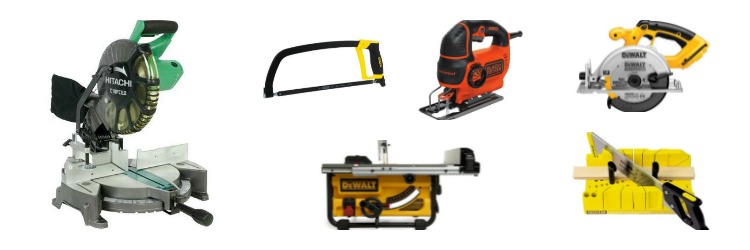
This tutorial contains affiliate links to supplies and tools. Purchases made using these links help support the Saws on Skates website and allows me to share more projects and tips with you. There is no cost to you for using these links. Visit my site policies for more information.
Types of Cuts
Before we jump into the types of saws, I want to review the types of cuts saws can make.
Cross-cut vs Rip Cut
A cross-cut is made across the grain of the wood. A rip cut is made with the grain of the wood. Please check out this post for more clarification on the difference between cross-cuts and rip cuts.
Miter Cut vs Bevel Cut
A miter cut is an angle cut made on the face of a piece of wood.
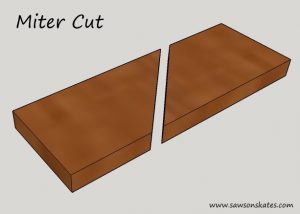
A bevel cut is an angle cut made on the edge of a piece of wood. A bevel cut changes the profile of the wood.
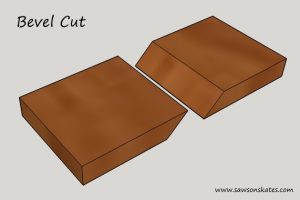
SHOP TIP: More teeth on a saw blade yields a smoother cut. Less teeth gives a rougher cut.
Hand Saws
Hand saws are powered by, you guessed it, your hands! Below are two of the most common hand saws you might want in your tool box for your next DIY project.
Hand Saw and Miter Box
Wood is placed in the miter box and the hand saw slides in the predetermined slots in the sides of the miter box to cut the piece to the desired length or angle.
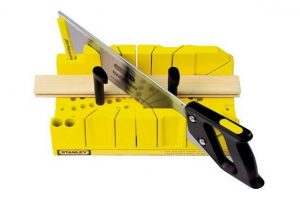
Type of cuts: A hand saw and miter box work best for cross-cuts and miter cuts.
DIY projects: If you’re new to DIY and saws, or don’t have a lot of room for a saw, a hand saw and miter box are a great place to start. It can be used for most projects where you would use a miter saw. It’s great for DIY furniture projects, installing baseboard molding, molding around windows and doors, plus more. The saw can also be used separately from the miter box.
Hacksaw
The hacksaw has a thin, fine tooth blade usually mounted in a metal “C” shaped frame.
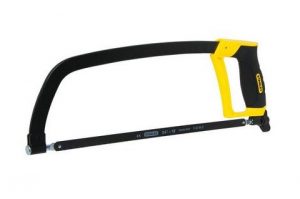
Type of cuts: A hacksaw works best for cross-cuts.
DIY projects: The hacksaw is commonly used for cutting small metal parts or metal pipe. I’ve used a hacksaw to cut a piano hinge to length. It can also be used for cutting plastic pipe or wooden dowels.
Power Saws
Power saws are powered by, you guessed it, an electric motor! Below are four of the most common power saws you might want in your arsenal for your next DIY project.
Jig Saw
The jig saw has an interchangeable blade that moves up and down, similar to the needle of a sewing machine. Most jig saws feature a base plate that can be tilted, so you can also make bevel cuts.
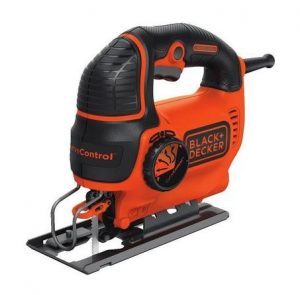
Type of cuts: A jig saw is commonly used to cut curves or unusual shapes. But it’s use is not limited to curves. In a pinch you could use it for a cross-cut, but a miter box and saw or miter saw would be a better choice.
DIY projects: I used a jig saw to cut the legs for this project and this project and to cut the handle for this project.
Circular Saw
A circular saw is a handheld saw with a rotating interchangeable blade. The blade can be raised and lowered to adjust for the thickness of the wood. The baseplate can be adjusted for bevel cuts.
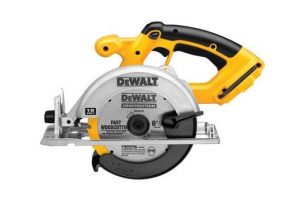
Type of cuts: The circular saw can be used for cross-cuts, rip cuts, miter cuts and bevel cuts. For accurate cuts the circular saw can be used with a square or crosscut jig.
Related: 4 Ways to Make Straight Cuts with a Circular Saw
DIY projects: A circular saw is a good choice for cutting plywood down to the required size. I used a circular saw to cut the chalkboard for this project and this project.
Related: How to Change a Blade on a Circular Saw
Miter Saw
Think of the miter saw as a cross between a miter box and circular saw. The saw is mounted overhead. The wood to be cut is placed on the base and against the fence. The blade can be adjusted to make miter cuts, bevel cuts or a miter with bevel cut. The miter saw is also known as a chop saw.
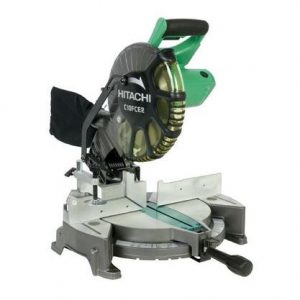
Type of cuts: A miter saw is great for making crosscuts, miter cuts and bevel cuts. The miter saw is probably the saw I use the most on my DIY projects.
Related: 7 Miter Saw Tricks Every DIYer Should Know
DIY projects: The miter saw is a great choice for DIY furniture projects, installing baseboard molding, molding around windows and doors, crown molding, plus much more.
Related: How to Adjust a Miter Saw for Accurate Cuts
Table Saw
Unlike the miter saw, the blade of the table saw is mounted below the table. The blade can raise, lower and tilt for bevel cuts. Wood is placed on the table and rides against an adjustable fence to make rip cuts.
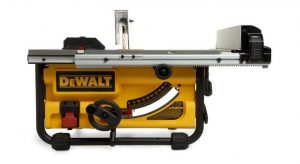
Type of cuts: The most common type of cut made with a table saw is a rip cut. A miter fence or cross-cut sled can be used to make cross-cuts.
Related: When to Use a Miter Saw vs Table Saw
DIY projects: The table saw is a great option for ripping 1x and 2x lumber to width. It’s also great for cutting down small pieces of plywood and MDF.
Related: Why You Should Wax Your Table Saw
Final Thoughts
These are probably the most common saws you’ll need for most DIY projects. Some of these saws, like the table saw, can make other cuts. For instance, when equipped with a set of dado blades, the table saw can make dado or groove cuts. Of course there are many saws we didn’t cover like a scroll saw, band saw, etc.
I hope this gives you a better idea of the names of saws, how they work and how they can be used. As always, please send me a message or post in the comments if you have any questions or need more clarification.
Recommended For You
Pin This For Later



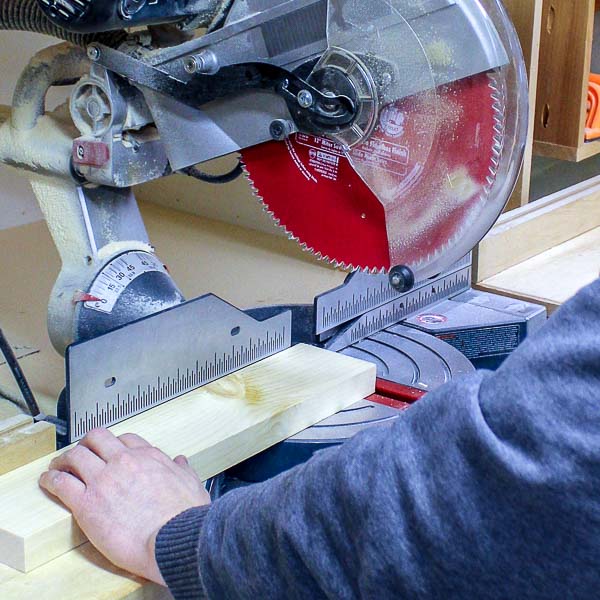
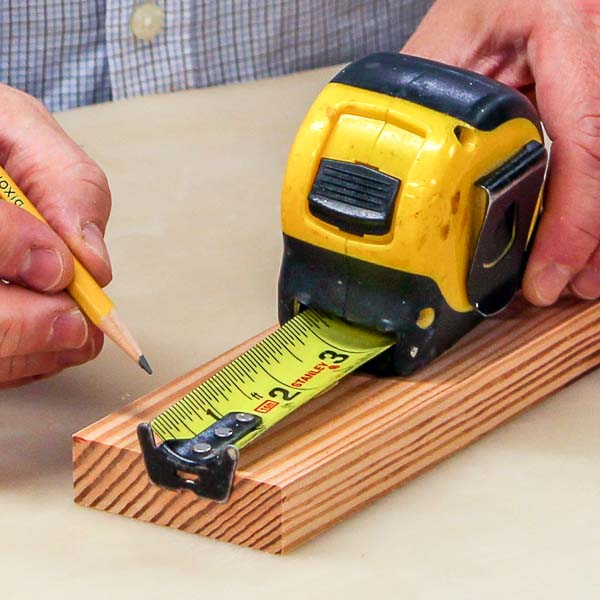
Thank you for the info!! Very informative!!
You’re welcome – I’m glad you found it useful!
Very nice. And now I’m ready for a tutorial on saw blades!
Thank you Nancy and I think you just gave me some inspiration for a new tutorial!